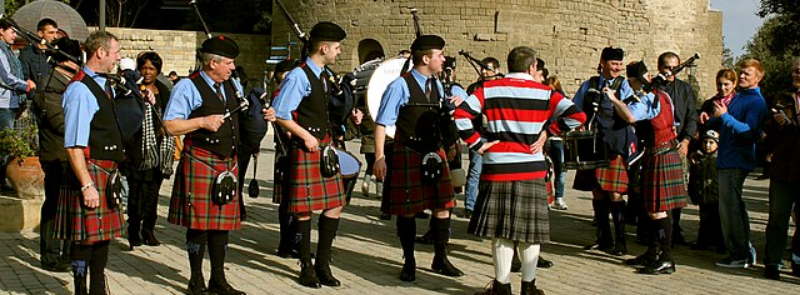
When It Occurs
Every November 30th
Timeline
Days Passed (683)
# Hashtags
#StAndrewsDay #FeastOfSaintAndrew
St. Andrew's Day, observed on November 30th, commemorates Saint Andrew, the patron saint of Scotland. Also known as the Feast of Saint Andrew or Andermas, this feast day gained significance in 1320 when the Declaration of Arbroath affirmed Saint Andrew as Scotland's patron saint during the country's declaration of independence. In 2007, the Scottish Parliament enacted the St. Andrew's Day Bank Holiday (Scotland) Act, designating the day as a bank holiday throughout Scotland.
Scotland marks the occasion with parades, traditional music and dance, and the enjoyment of Scottish cuisine. Notably, the St. Andrew's Day Torchlight Parade in Glasgow's West End features thousands of pipe bands, spectators, and fire dancers.
Key Details about St. Andrew’s Day:
1. Who was St. Andrew?
- St. Andrew was one of the twelve apostles of Jesus Christ and is believed to have been a fisherman by trade. According to Christian tradition, he was the brother of St. Peter and was martyred for his faith by crucifixion on an X-shaped cross (now known as the saltire or St. Andrew's cross).
- St. Andrew is not only the patron saint of Scotland but also of Russia, Greece, and Romania, among others. He is often associated with virtues of kindness, humility, and a sense of duty.
2. Why is St. Andrew Scotland's Patron Saint?
- There are several legends about how St. Andrew became the patron saint of Scotland. One tradition states that his relics were brought to Scotland (then known as Alba) by St. Regulus in the 4th century. Another popular legend claims that King Óengus II of Scotland (8th century) saw an X-shaped cross in the sky before a battle against the Anglo-Saxons, which led to his victory. This miraculous vision was interpreted as a sign from St. Andrew, leading the king to adopt him as the national saint.
- St. Andrew’s association with Scotland is also linked to the saltire, the X-shaped cross that became the national flag of Scotland, known as the St. Andrew’s Cross.
3. National Significance:
- St. Andrew’s Day has been a day of great national pride for Scots for centuries, symbolizing Scottish identity and its rich heritage. It’s a public holiday in Scotland and seen as an opportunity for Scots to reflect on their history, traditions, and culture.
- The day is seen as the unofficial start of Scotland’s winter festival season, which includes Hogmanay (New Year’s Eve) and Burns Night (January 25th, celebrating the poet Robert Burns).
4. Traditional Celebrations:
- Feasts and Food: St. Andrew’s Day is often celebrated with a traditional Scottish feast, including iconic dishes like haggis, neeps and tatties (turnips and potatoes), Scotch broth, and Cranachan (a dessert made with oats, whisky, and cream). Many families and communities gather for festive meals in honor of the day.
- Scottish Dancing: Traditional ceilidh dancing is a central feature of St. Andrew’s Day celebrations. A ceilidh is a social event featuring Scottish folk music and dancing. Many events across Scotland and beyond will host ceilidh nights, where participants enjoy lively traditional reels, jigs, and waltzes.
- Music and Bagpipes: Scottish music, especially played on bagpipes, is a key part of the festivities. Many events feature performances of Scottish folk music, including songs like "Auld Lang Syne" and the famous "Flower of Scotland."
5. Modern Celebrations and Events:
- Across Scotland, St. Andrew’s Day is marked with a variety of events, ranging from community gatherings to concerts, parades, and festivals. Some towns and cities, like St. Andrews in Fife, often host larger celebrations that draw visitors from across the country.
- The day also offers an opportunity for people to learn more about Scottish history and culture, with many museums and heritage sites offering free admission or special programs in honor of the day.
- Edinburgh and Glasgow typically host large celebrations featuring live music, dancing, and fireworks.
6. St. Andrew’s Day in the United Kingdom:
- While most strongly associated with Scotland, St. Andrew’s Day is also celebrated in other parts of the UK, especially where there are strong Scottish communities. Some UK government buildings fly the saltire (the Scottish flag) on this day, and there may be special events in areas with Scottish ties.
- In England, Wales, and Northern Ireland, St. Andrew’s Day is not a public holiday, but it may be observed in Scottish cultural groups or societies.
7. Scottish Diaspora and International Celebrations:
- Outside the UK, St. Andrew’s Day is also celebrated by Scottish expatriates and descendants of Scots across the world. In places like Canada, the United States, Australia, and New Zealand, where there are significant Scottish communities, the day is often marked with cultural festivals, ceilidhs, and dinners.
- Organizations such as The Scottish Society or St. Andrew’s Societies in various cities around the world often organize formal dinners, fundraisers, and events to honor St. Andrew’s Day.
8. Religious Observances:
- As a saint’s day, religious observances still play a part in St. Andrew’s Day celebrations. Churches across Scotland and the UK hold special services in honor of St. Andrew, reflecting his significance in Christian tradition.
- In Roman Catholic, Anglican, and Orthodox churches, prayers and hymns dedicated to St. Andrew are often featured during services.
9. St. Andrew’s Day as a Public Holiday in Scotland:
- In 2006, the Scottish Parliament officially declared St. Andrew’s Day a bank holiday, although not all businesses or schools close for the day. The holiday status reflects the growing recognition of the importance of celebrating Scotland’s national identity and cultural heritage.
- St. Andrew’s Day is also seen as an inclusive celebration, promoting solidarity and welcoming people from all backgrounds to participate in Scottish traditions.
10. Connection to Scottish Independence Movement:
- In recent years, St. Andrew’s Day has taken on additional significance for some in the context of Scottish independence. For supporters of an independent Scotland, the day is a symbol of Scotland’s unique identity and aspirations for greater autonomy.
11. Symbols of St. Andrew’s Day:
- The Saltire (St. Andrew’s Cross): The blue and white flag of Scotland, known as the saltire, is flown proudly on St. Andrew’s Day. It represents the X-shaped cross on which St. Andrew is believed to have been crucified.
- Thistles: The thistle, Scotland’s national flower, is often associated with St. Andrew’s Day, and many people wear a thistle emblem or pin on their clothing in honor of the day.
12. Connection to Other Scottish Festivals:
- St. Andrew’s Day also serves as the starting point for Scotland’s winter festivals, leading up to the grand celebrations of Hogmanay (Scottish New Year) and continuing to Burns Night on January 25th.
- Many cultural events that begin on St. Andrew’s Day continue through the holiday season, keeping the festive spirit alive in Scotland.
Conclusion:
St. Andrew’s Day is a celebration of Scottish culture, history, and national pride. Rooted in the legacy of St. Andrew, the day is an opportunity for Scots and those with Scottish connections to reflect on their heritage, participate in traditional customs, and enjoy the rich traditions of music, dance, and food. Whether through ceilidh dancing, bagpipe performances, or a traditional Scottish feast, St. Andrew’s Day is a day for unity and celebration. It marks the beginning of Scotland’s winter festivities and serves as a reminder of the enduring importance of Scottish identity, both within the UK and worldwide.


